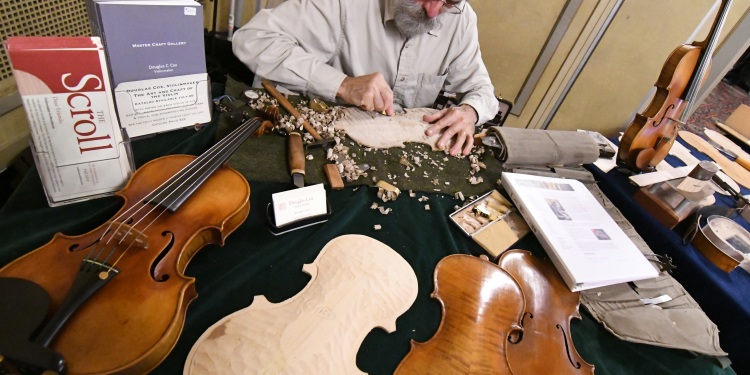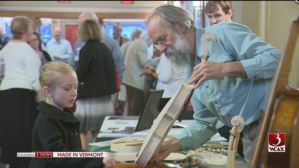By Sara Munro
At every event, we get to know the people who fill the seats and whom we think of as family. We love to hear what inspired you most about a performance and your ideas for expanding our reach in Vermont. Last year, one idea rose above all others and became a remarkable journey: show us what is inside a violin.
From Concept to Workshop
This kernel of an idea launched our first, year-long Violinmaker-in-Residence program with Douglas Cox. To the best of our knowledge, the VSO is the only orchestra in America to commission a luthier (aka violinmaker) for the purpose of demonstrating each stage of production. Over the 2016/17 season, Cox revealed the process of crafting a violin with hands-on demonstrations at performances and an extensive written journal/blog about the process. “For many people, the instruments on stage are a mystery,” explains VSO Executive Director Benjamin Cadwallader. “Yet working with wood and assembling pieces are familiar to nearly everyone. By seeing and touching each part, people were able to connect with the process, the instrument, and the music.”
Each step of the VSO violin making was intentional, from selecting the wood to its opening night on stage. Cox choose aged wood native to Vermont and New England so that this instrument would be rooted in the Green Mountains from the beginning and carry a uniquely Vermont sound. He then used a pattern that he made from VSO Music Director Jaime Laredo’s own Stradavari violin, an instrument (though no longer owned by Laredo) that turns 300 years old this year. Cox writes poetically about breathing life into bits of wood and string.
On setting the strings, he wrote, “The strings provide the life energy that will set the wood of the violin to dancing, and perhaps the people who hear it.”
Taking the Stage
On May 6, the VSO violin was ready to take the stage in the hands of Assistant Concertmaster Kathy Andrew. She had three weeks before the concert to “play-in” the violin – we use the phrase “play-in” instead of “break-in” because who would want to break a piece of art?! Both Andrew and Cox will say that a violin is only halfway finished when it leaves his shop. It takes a year of playing before it is truly complete. Andrew remarked on the unique moment in time; “Tonight we’re playing pieces that are nearly 200 years old. To think that this violin could still be played 200 years – and beyond – from now is just inspiring.”
What is Next for the VSO Violin
While the violin is only a few months old, we know that it will last for 300 years or more just like the violin it was modeled after and the state in which it was born. The VSO Violin will appear throughout the year at our concerts. It is currently available for purchase through Cox Violins, with a portion of the proceeds to benefit the Vermont Symphony Orchestra. The hope is that, through the generosity of the community, we are able to keep the violin in the VSO family for many years to come.
Read more about the VSO Violin in earlier blog posts here and here.
Watch Scott Fleischman’s Made in Vermont story for WCAX by clicking on the video below.



